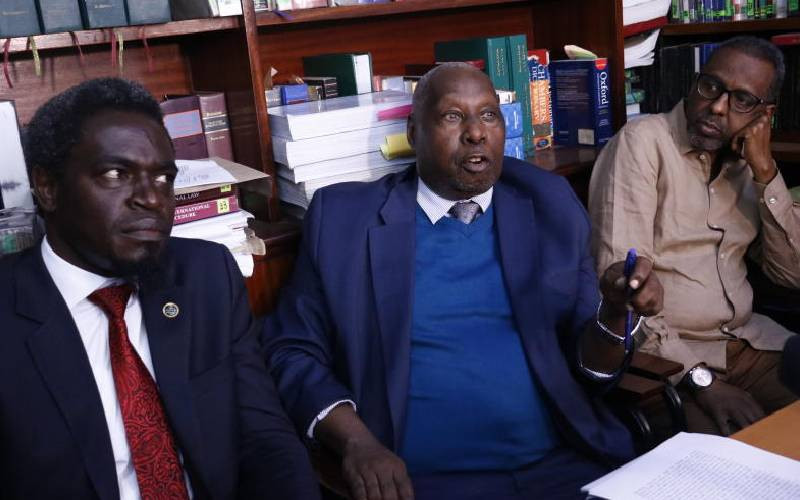
The world is mourning departed Queen Elizabeth II, but the Talai clan who originally hailed from Nandi can only collectively sigh in grief and wonder why she has refused to heed their desperate cries for 70 years.
Theirs is a story of Kenya's longest-suffering community. Their tribulations resonate with the history of Jews; targeted for extermination by Adolf Hitler's regime during the Second World War.
The Talai's resistance to the British occupation was spearheaded by their most illustrious prophet of modern times, Koitalel Arap Samoei, a military genius who harassed the superior colonial forces for over ten years.
Koitalel had warned the Nandi about the ulterior motives of the visitors and staged a spirited resistance against the British from 1895 to 1905.
During the protracted war, Nandi warriors made it impossible to construct the railway.
Historical records show that the British killed Koitalel, after duping him into attending a peace meeting only to be shot in cold blood by captain Richard Meinertzhagen, who had been assigned the duty of capturing Koitalel.
In his book, Kenya Diary (1902-1906), Meinertzhagen records how he and Koitalel had tried to outwit each other by planting spies and employing black magic.
According to Meinertzhagen, an attractive young virgin was allegedly sent by the Orkoiyot on October 12, 1905 at Nandi Fort as a peace offering.
Meinertzhagen recounts that when Sir Donald Stewart, Kenya Protectorate's Commissioner died on October 1, 1905, shortly before the Nandi punishing expedition commenced, it was attributed to Koitalel's psychic powers.
To capture and kill, Meinhertzhagen had at his disposal 7,648 soldiers, policemen, spies, Maasai levies and porters transported in two armoured trains.
On September 26, 1905, Koitalel allegedly convened his war council to finalise plans of finishing off the rebellion he had sustained for the last decade.
The epic battle between the two strategists, Koitalel and Meinertzhagen took place on October 19, 1905, at around 11.15 am and Koitalel refused to shake hands.
Meinertzhagen took this as treachery, grabbed his hand and used him as a human shield.
Meinertzhagen noted: "I seized the Laibon and dragged him forward, getting scratched by his spear. The Orkoiyot wrenched himself free. I am unable to state with certainty what followed. The Laibon was shot simultaneously by myself and my native officer (Mbaruk Effendi). I took two stone-headed knob kerries from the Laibon's belt."
After the Laibon was killed, the British tried to endear themselves to Kipchober arap Koilegen, who resided in Kericho by promoting him to a paramount chief although they had already found him an established leader among the Kipsigis.
They tried to woo Koitalel's brother by organising a trip for him to the Coast, where he and his seven advisers were taken to Mombasa and feted like celebrities in the hope that Koilegen would sign away the land in Kericho for tea growing.
Somehow, the British did finalise a plan aimed at disciplining Koilegen for his insolence and rid the entire Nandi and Kipsigis land of the influence of the Talai clan.
On January 7, 1914, Koilegen, his brother Boisio and Kibuigut were tricked into travelling to Kipkelion (Lumbwa Station) where they were slapped with detention orders and transported to Nairobi in a cargo train before being taken to Murang'a, Nyeri and Meru.
Deprived of their spiritual leaders and still reeling from the shock of the detention of their leaders, the colonial regime delivered a sucker punch when it rounded up all Talai clan members in Nandi and confined them in a concentration camp in 1920s.
The remaining Talai clan members, numbering about 110 families, were rounded up in 1934 after the British security agencies allegedly seized weapons, which had been stolen by some of the Talai military recruits, who had participated in the First World War.
They were forced to march to Gwassi, a tsetse flies invested region in Nyanza, where some ingenious administrators hoped they would perish, together with their livestock.
In the meantime, the Laibon's Removal Ordinance Act was passed, legitimising the mass deportation of 700 members of the clan after King George, the Queen's father gave his consent in September 1934.
The superficial reason given then was that the clan had an evil influence on the Kalenjin population.
The removal envisioned by the law was "removal to the settlement area and compulsory settlement in the "rocky area with high hills' on the shores of Lake Victoria at Mung'ori Bay, which the ordinance described as "cairn.
Those who attempted to travel back to their ancestral land were rounded up and charged and sentenced to six months in jail.
They all died in detention, which paved the way for the British to execute their plan of removing the entire clan from their ancestral land so that they could grow tea.
The frustrations and bewilderment of Kenyans over the plight of the Talai are captured by a letter authored by one brave policeman, Ndoigo Titilei, who breached protocol and attempted to write to Baraza, a Kiswahili newspaper in 1944.
He wondered what crime the entire Talai community had committed to deserve a collective jail term, noting the area they had been taken to was uninhabitable while their livestock was being wiped out by disease.
Regardless of whatever crimes they had committed, the police officer in the letter, which was intercepted by his District Commissioner and forwarded to the Nyanza PC observed that for 10 years, no youth had been allowed to marry.
On November 14, 1945, ten years after translocation, Kericho DC, telegrammed his boss the Nyanza Provincial Commissioner about the fate of the Talai clan and what he thought was the final solution.
"In all respect, I think we should face up to the fact that we should concentrate on the children and leave the old men to die out gradually as brutal as it may seem. If we do this, the area around the township should be sufficient. I have no sympathy for the old age grade, who made life so difficult for the government in the past," the administrator wrote."
This telegram confirms the government policy at the time, which was to allow some of the young men and women to return from Gwassi, but were not allowed to interact freely with the other residents of Kericho.
Instead, they were accommodated in a concentrated area where they had to obtain special permission whenever they were required to travel.
In 1962, when the colonial administration started relinquishing the reins of power, they softened their stance towards the Talai and allowed the clan back to Kericho after more than 30 years in captivity.
After their return from exile, the Talai clan members have been squatting on Municipal Council land, where they were directed to wait as the government sought alternative land to settle them.
After 78 years of broken promises, the Talai are tired of turning the other cheek and are now preparing to sue for their rights and hopefully, the elusive justice will finally be served.
 The Standard Group Plc is a multi-media organization with investments in media platforms spanning newspaper print
operations, television, radio broadcasting, digital and online services. The Standard Group is recognized as a
leading multi-media house in Kenya with a key influence in matters of national and international interest.
The Standard Group Plc is a multi-media organization with investments in media platforms spanning newspaper print
operations, television, radio broadcasting, digital and online services. The Standard Group is recognized as a
leading multi-media house in Kenya with a key influence in matters of national and international interest.











